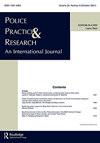You can’t manage what you can’t measure: the importance of data in policing
IF 1.8
Q2 CRIMINOLOGY & PENOLOGY
引用次数: 1
Abstract
In recent years, politicians and reporters have highlighted the lack of data on many policing outcomes, with a sharp focus on how little we know about police use of force in both the United States and internationally. Specifically, the death of Michael Brown in Ferguson (MO) in 2014 highlighted the fact that no entity within the United States tracks police use of force, even deadly force. This lack of data leadership prompted several news agencies to begin tracking civilian deaths at the hands of police, the most well-known of which is The Washington Post Fatal Force database (Nix et al., 2017; Shjarback & Nix, 2020). Yet while use of force is a crucial responsibility of police and more information is certainly needed (Bennell et al., 2022; Matusiak et al., 2022; White, 2016; Williams et al., 2019), it is not the only aspect of policing that could benefit from more and better data. Historically, police accountability has been measured by outcomes that are easily countable, such as arrest and case clearance rates, citations, traffic stops, and response times. While important, these data fall short of assessing the myriad responsibilities that police organizations are tasked with measuring, and they tell us little about the nature and extent of these community encounters. These outcomes are, however, of critical importance to community members and larger police reform efforts. Police departments do collect a great deal of interesting and informative data that can add context to the discourse about police work at both the individual and organizational levels. Recent research has touched on the ways in which police data impacts various facets of police work and highlights the possibilities for new, innovative uses for police data. For example, Lum et al. (2021) and Ratcliffe (2021) demonstrated the difficulty inherent in reallocating police calls to other, nonpolice entities for many calls traditionally yielding a police response. Muller and colleagues find that scant information is known about police responses during calls involving mental health crises. Gillooly (2021) asks important questions about how dispatchers shape police responses to incidents independent of incident data. White et al. (2018) interrogate the use of body-worn camera footage to reduce the use of force in encounters with community members. Yet despite these and other studies using police data, many questions remain about the utility of administrative data in law enforcement agencies. This special issue begins by exploring data sources and asking some important questions about the nature of policing for researchers across the globe. In this special issue, several papers include new ways to utilize incident-level data of offensespecific trends. Pearce and Simpson (2022) use Computer Aided Dispatch (CAD) data to better understand the nature and extent of welfare checks – an understudied responsibility of local police that often does not involve law enforcement. Barnett-Ryan (2022) uses calls-for-service data and incident reports from municipal and university police agencies to analyze the spatial co-location of property crime. Haberman et al. (2021) and Scott et al. (2021) both make use of the U.S. Federal Bureau of Investigation’s National Incident-Based Reporting System (NIBRS) data. Haberman et al. (2021) use these data to better understand robberies within one agency, while Scott et al. (2021) compare clearance rates for sexual assault cases across multiple agencies. Holistically, O’Connor et al. (2022) add to recommendations for agencies about the role of police analysts in a shift to evidenced-based policing in Canada. POLICE PRACTICE AND RESEARCH 2022, VOL. 23, NO. 4, 397–399 https://doi.org/10.1080/15614263.2022.2066781你无法管理你无法衡量的东西:警务中数据的重要性
近年来,政界人士和记者强调,许多警务结果缺乏数据,重点是我们对美国和国际上的警察使用武力知之甚少。具体而言,2014年迈克尔·布朗在弗格森(密苏里州)的死亡凸显了这样一个事实,即美国境内没有任何实体跟踪警察使用武力,甚至是致命武力。由于缺乏数据领导力,一些新闻机构开始追踪警察造成的平民死亡,其中最著名的是《华盛顿邮报》致命武力数据库(Nix等人,2017;Shjarback & Nix, 2020)。然而,虽然使用武力是警察的关键责任,但肯定需要更多的信息(Bennell et al., 2022;Matusiak et al., 2022;白色,2016;Williams等人,2019),这并不是警务工作中唯一可以从更多更好的数据中受益的方面。从历史上看,警察问责一直是通过容易计数的结果来衡量的,比如逮捕率和案件清除率、传票、交通拦截和反应时间。虽然这些数据很重要,但它们无法评估警察组织所承担的无数责任,也无法告诉我们这些社区遭遇的性质和程度。然而,这些成果对社区成员和更大范围的警察改革工作至关重要。警察部门确实收集了大量有趣和翔实的数据,这些数据可以为个人和组织层面的警察工作论述增添背景。最近的研究触及了警察数据影响警察工作各个方面的方式,并强调了警察数据新的创新用途的可能性。例如,Lum等人(2021)和Ratcliffe(2021)证明了将警察呼叫重新分配给其他非警察实体的固有困难,因为许多呼叫通常会产生警察响应。穆勒和他的同事们发现,在涉及心理健康危机的电话中,警方的反应知之甚少。Gillooly(2021)提出了关于调度员如何在独立于事件数据的情况下塑造警察对事件的反应的重要问题。White等人(2018)对使用穿戴式摄像机镜头来减少与社区成员相遇时使用武力进行了调查。然而,尽管这些研究和其他研究使用了警察数据,关于执法机构行政数据的效用仍然存在许多问题。本期特刊首先探讨了数据来源,并为全球研究人员提出了一些关于警务性质的重要问题。在本期特刊中,几篇论文介绍了利用犯罪特定趋势的事件级数据的新方法。Pearce和Simpson(2022)使用计算机辅助调度(CAD)数据来更好地了解福利检查的性质和范围——这是当地警察的一项未被充分研究的责任,通常不涉及执法。Barnett-Ryan(2022)使用来自市政和大学警察机构的服务呼叫数据和事件报告来分析财产犯罪的空间共地。Haberman等人(2021)和Scott等人(2021)都使用了美国联邦调查局的国家事件报告系统(NIBRS)数据。Haberman等人(2021)使用这些数据来更好地了解一个机构内的抢劫,而Scott等人(2021)比较了多个机构间性侵犯案件的清除率。总体而言,O 'Connor等人(2022)为各机构提供了关于警察分析师在加拿大向循证警务转变中的作用的建议。《警察实践与研究2022》第23卷第2期。4,397 - 399 https://doi.org/10.1080/15614263.2022.2066781
本文章由计算机程序翻译,如有差异,请以英文原文为准。
求助全文
约1分钟内获得全文
求助全文
来源期刊

Police Practice and Research
CRIMINOLOGY & PENOLOGY-
CiteScore
4.10
自引率
5.60%
发文量
50
期刊介绍:
Police Practice and Research is a peer-reviewed journal that presents current and innovative police research as well as operational and administrative practices from around the world. Articles and reports are sought from practitioners, researchers and others interested in developments in policing, analysis of public order, and the state of safety as it affects the quality of life everywhere. Police Practice and Research seeks to bridge the gap in knowledge that exists regarding who the police are, what they do, and how they maintain order, administer laws, and serve their communities. Attention will also be focused on specific organizational information about the police in different countries or regions. There will be periodic special issues devoted to a particular country or continent.
 求助内容:
求助内容: 应助结果提醒方式:
应助结果提醒方式:


